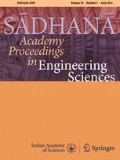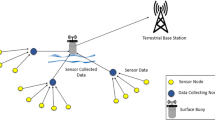Abstract
Development of energy-efficient data collection and routing schemes for Underwater Wireless Sensor Networks (UWSNs) is a challenging issue due to the peculiarities of the underlying physical layer technology. Since the recharging or replacement of sensor nodes is almost impossible after deployment, the critical issue of network lifetime maximization must be considered right from the beginning of designing the routing schemes. We propose a mobile sink (MS)-based data collection scheme that can extend network lifetime, taking into account power-constrained sensor nodes, partitioned networks with geographically distant data collection points and periodic monitoring applications with delay-tolerance. Lifetime extension is achieved by mitigating the ‘sink neighbourhood problem’ and by deferring the data transmissions until the MS is at the most favourable location for data transfer. Unlike the models available for terrestrial WSNs, we consider non-zero travel time of the MS between data collection points, thus making our model more realistic for UWSNs, both connected and partitioned. The performance of the proposed mobility-assisted data collection scheme is thoroughly investigated using both analytical and simulation models. The analytical results are compared to those of existing models to assess their effectiveness and to investigate the trade-offs. Results show that, with a network size of 60 nodes, the network lifetime achieved by the proposed model is 188% higher than that of static sink model and 91% higher than that of mobile sink model (MSM). The proposed maximum lifetime routing scheme is implemented in the network simulation platform OMNET++, for validating the analytical results as well as for evaluating other performance metrics that are not tractable via analytical methods. Both analytical and simulation results demonstrate the superiority of the proposed model in capturing realistic network conditions and providing useful performance indicators prior to network deployment.
















Similar content being viewed by others
References
Akyildiz I F, Pompili D and Melodia T 2005 Underwater acoustic sensor networks: research challenges. Ad hoc Netw. 3(3): 257–279
Heidemann J, Stojanovic M and Zorzi M 2012 Underwater sensor networks: applications, advances and challenges. Philos R. Soc. London A: Math Phy. Eng. Sci 370(1958): 158–175
Basagni S, Carosi A, Melachrinoudis E, Petrioli C and Wang Z M 2008 Controlled sink mobility for prolonging wireless sensor networks lifetime. Wireless Netw. 14(6): 831–858
Dietrich I and Dressler F 2009 On the lifetime of wireless sensor networks. ACM Trans. Sensor Netw. 5(1): 5
Chen Y and Zhao Q 2005 On the lifetime of wireless sensor networks. Commun. Lett. IEEE 9(11): 976–978
Kartha J M J and Jacob L 2014 Lifetime enhancement in sparse underwater acoustic sensor networks using mobile elements. In: Procecding of the IEEE International Conference on Signal Processing and Communications (SPCOM), pp. 1–6
Rao J and Biswas S 2012 Analyzing multi-hop routing feasibility for sensor data harvesting using mobile sinks. J. Parallel Distrib. Comput. 72(6): 764–777
The omnet++ discrete event simulation system. [Online]. Available: http://www.omnetpp.org
Ayaz M, Baig I, Abdullah A and Faye I 2011 A survey on routing techniques in underwater wireless sensor networks. J. Netw. Comput. Appl. 34(6): 1908–1927
Xie P, Cui J H and Lao L 2006 VBF: vector-based forwarding protocol for underwater sensor networks. In: Proceedings of Networking 2006: Networking Technologies, Services, and Protocols; Performance of Computer and Communication Networks; Mobile and Wireless Communications Systems. Berlin Heidelberg: Springer, pp. 1216–1221
Xie P, Zhou Z, Nicolaou N, See A, Cui J H and Shi Z 2010 Efficient vector-based forwarding for underwater sensor networks. EURASIP J. Wireless Commun. Netw. 2010(1): 1–13
Pompili D, Melodia T and Akyildiz I F 2010 Distributed routing algorithms for underwater acoustic sensor networks. IEEE Trans. Wireless Commun. 9(9): 2934–2944
Domingo M C and Prior R 2008 Energy analysis of routing protocols for underwater wireless sensor networks. Comput. Commun. 31(6): 1227–1238
Zorzi M, Casari P, Baldo N and Harris III A F 2008 Energy-efficient routing schemes for underwater acoustic networks. IEEE J. Sel. Areas Commun. 26(9): 1754–1766
Shah R C, Roy S, Jain S and Brunette W 2003 Data mules: Modeling and analysis of a three-tier architecture for sparse sensor networks. Ad Hoc Netw. 1(2): 215–233
Somasundara A A, Kansal A, Jea D D, Estrin D and Srivastava M B 2006 Controllably mobile infrastructure for low energy embedded networks. IEEE Trans. Mobile Comput. 5(8): 958–973
Wang W, Srinivasan V and Chua K C 2005 Using mobile relays to prolong the lifetime of wireless sensor networks. In: Proceedings of the 11th Annual International Conference on Mobile computing and networking, ACM, pp. 270–283
Jea D, Somasundara A and Srivastava M 2005 Multiple controlled mobile elements (data mules) for data collection in sensor networks. In: Proceedings of Distributed computing in Sensor Systems. Heidelberg: Springer Berlin, pp. 244–257
Gandham S R, Dawande M, Prakash R and Venkatesan S 2003 Energy efficient schemes for wireless sensor networks with multiple mobile base stations. In: IEEE Global Telecommunications Conference, 2003. GLOBECOM’03, vol. 1, pp. 377–381
Chang J H and Tassiulas L 1999 Routing for maximum system lifetime in wireless ad-hoc networks. In: Proceedings of the Annual Allerton Conference on Communication Control and Computing, vol. 37, pp. 1191–1200. The University
Azad A P and Chockalingam A 2006 Mobile base stations placement and energy aware routing in wireless sensor networks. In: IEEE Proceedings of the Wireless Communications and Networking Conference, 2006, WCNC 2006, vol. 1, pp. 264–269
Wang Z M, Basagni S, Melachrinoudis E and Petrioli C 2005 Exploiting sink mobility for maximizing sensor networks lifetime. In: Proceedings of the 38th Annual Hawaii International Conference on System Sciences, 2005. HICSS’05, pp. 287a–287a. IEEE
Papadimitriou I and Georgiadis L 2005 Maximum lifetime routing to mobile sink in wireless sensor networks. In: Proceeding of SoftCOM
Luo J and Hubaux J P 2010 Joint sink mobility and routing to maximize the lifetime of wireless sensor networks: the case of constrained mobility. IEEE/ACM Trans. Netw. 18(3): 871–884
Yun Y and Xia Y 2010 Maximizing the lifetime of wireless sensor networks with mobile sink in delay-tolerant applications. IEEE Trans. Mobile Comput. 9(9): 1308–1318
Keskin M E, Altnel K, Aras N and Ersoy C 2011 Lifetime maximization in wireless sensor networks using a mobile sink with nonzero traveling time. Comput. J. 54(12): 1987–1999
Dou J, Zhang G, Guo Z and Cao J 2008 PAS: probability and sub optimal distance based lifetime prolonging strategy for underwater acoustic sensor networks. Wireless Commun. Mobile Comput. 8(8): 1061–1073
Luo J and Hubaux J P 2005 Joint mobility and routing for lifetime elongation in wireless sensor networks. Proc. IEEE 3: 1735–1746
Lingo 15.0 optimization modeling software for linear, nonlinear, and integer programming. [Online]. Available: www.lindo.com/products/lingo/
Robert J U 1983 Principles of underwater sound. New York: McGraw-Hill
Berkhovskikh L and Lysanov Y 1982 Fundamentals of ocean acoustics. Springer
Bertsekas D P, Gallager R G and Humblet P 1992 Data networks, vol. 2. New Jersey: Prentice-Hall International
Takagi H 1990 Stochastic analysis of computer and communication systems. Elsevier Science
Kartha J J and Jacob L 2015 Delay and lifetime performance of underwater wireless sensor networks with mobile element based data collection. Int. J. Distrib. Sensor Netw. Article ID 128757
Dou J et al 2008 Optimum transmission range for underwater acoustic sensor networks. In: Proceedings of the IEEE International Conference on Information Networking
Zhao L and Liang Q 2006 Optimum cluster size for underwater acoustic sensor networks. In: Proceedings of MILCOM 2006, IEEE Military Communications Conference, pp. 1–5
Hassan M M, Ramadan R A and El Boghdadi H M 2014 Finding the Best Sink Location in WSNs with Reliability Route Analysis. Procedia Comput. Sci. 32: 1160–1167
Hu T and Fei Y 2010 QELAR: a machine-learning-based adaptive routing protocol for energy-efficient and lifetime-extended underwater sensor networks. IEEE Trans. Mobile Comput. 9(6): 796–809
Author information
Authors and Affiliations
Corresponding author
Rights and permissions
About this article
Cite this article
Kartha, J.J., Jacob, L. Network lifetime-aware data collection in Underwater Sensor Networks for delay-tolerant applications. Sādhanā 42, 1645–1664 (2017). https://doi.org/10.1007/s12046-017-0713-x
Received:
Revised:
Accepted:
Published:
Issue Date:
DOI: https://doi.org/10.1007/s12046-017-0713-x




